Introduction
Dumbbell Lower Chest Workout targets the lower chest muscles, which is an essential part of building a well-defined chest. The lower chest muscles, also known as the pectoralis major, are responsible for the lower portion of the chest’s shape and size. Focusing on this area of the chest not only enhances its appearance but also strengthens the chest muscles, improving overall upper-body strength.
Using dumbbells for chest exercises provides several benefits over other workout equipment. Dumbbells allow for a greater range of motion, enabling you to target specific muscle groups, including the lower chest muscles. Moreover, the use of dumbbells engages more stabilizing muscles, which help build strength and improve balance. Finally, using dumbbells is a versatile and cost-effective way to get a full-body workout at home or at the gym.
Warm-up for Dumbbell Lower Chest Workout
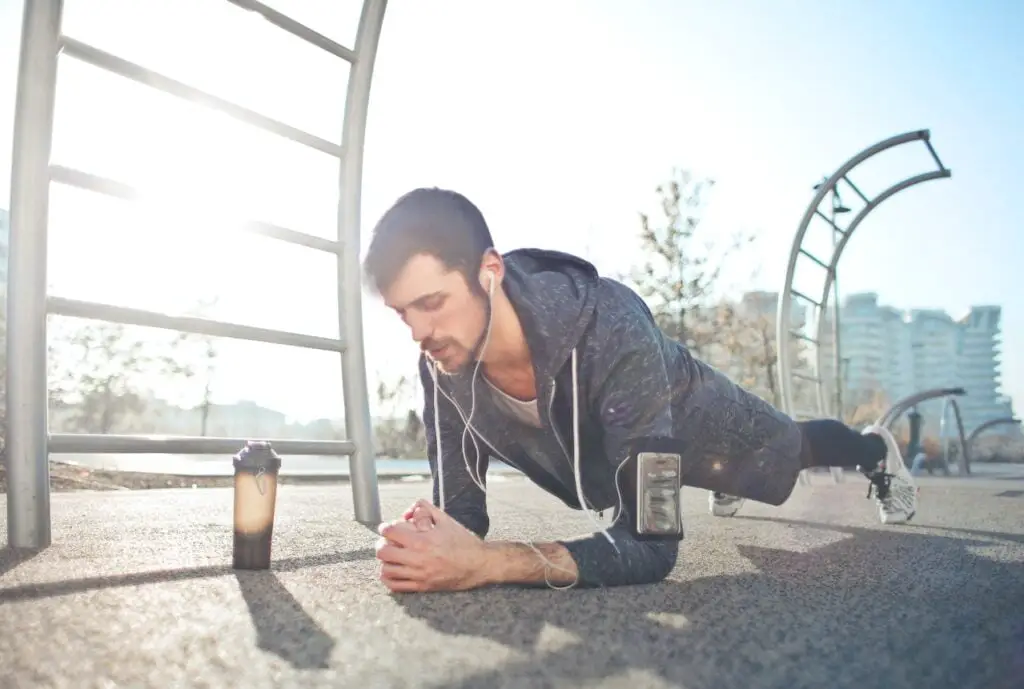
A proper warm-up is essential before beginning any Dumbbell Lower Chest Workout. The warm-up should include dynamic stretches and exercises that increase blood flow to the muscles, improve flexibility, and prepare the chest muscles for the workout. Here’s an example of a warm-up routine for a Dumbbell Lower Chest Workout:
Dynamic stretches are an essential part of a Dumbbell Lower Chest Workout as they help increase blood flow to the muscles, increase flexibility, and prepare the chest muscles for exercise. Some examples of dynamic stretches for the chest muscles include:
- Arm circles: Stand with your feet shoulder-width apart and arms extended out to the sides. Make small circles with your arms, gradually increasing the size of the circles.
- Push-up variations: Do a few reps of push-ups, starting with a modified push-up, such as from your knees, and gradually progressing to more challenging variations, such as incline or decline push-ups.
- Chest fly motion with light weights: Hold a light dumbbell in each hand and lie down on a flat bench or exercise mat. Extend your arms out to the sides, keeping them straight, and slowly bring the weights together over your chest, as if you were performing a chest fly.
- Inchworms: Stand with your feet hip-width apart, then hinge at the hips and walk your hands forward until you’re in a plank position. Walk your feet back to your hands, then stand up and repeat.
- Scapular push-ups: Start in a plank position with your hands shoulder-width apart. Lower yourself down, keeping your elbows close to your sides, and then push back up. This exercise targets the muscles between your shoulder blades, which are important for stabilizing your chest during exercises.
- Standing pec stretch: Stand facing a wall or a doorway, then place your hands on the surface and lean forward, stretching your chest muscles. You can vary the stretch by adjusting the height of your hands or changing the angle of your body.
- Medicine ball slams: Hold a medicine ball or a dumbbell and lift it overhead, then slam it down to the ground in front of you. This exercise not only stretches your chest muscles but also engages your core and upper body muscles.
Incorporating these dynamic stretches into your warm-up routine before starting your Dumbbell Lower Chest Workout can help prevent injury and maximize the benefits of your workout.
Main Workout
Dumbbell Lower Chest Workout typically includes a combination of exercises that target the lower chest muscles using dumbbells. Here are some exercises that you can include in your main workout:
Incline Dumbbell Bench Press

Lie on an incline bench with your feet firmly on the ground. Hold a dumbbell in each hand and lift them up to your shoulders. Push the dumbbells up towards the ceiling and then lower them down to your chest, keeping your elbows at a 45-degree angle. This exercise targets both the upper and lower chest muscles.
Decline Dumbbell Bench Press
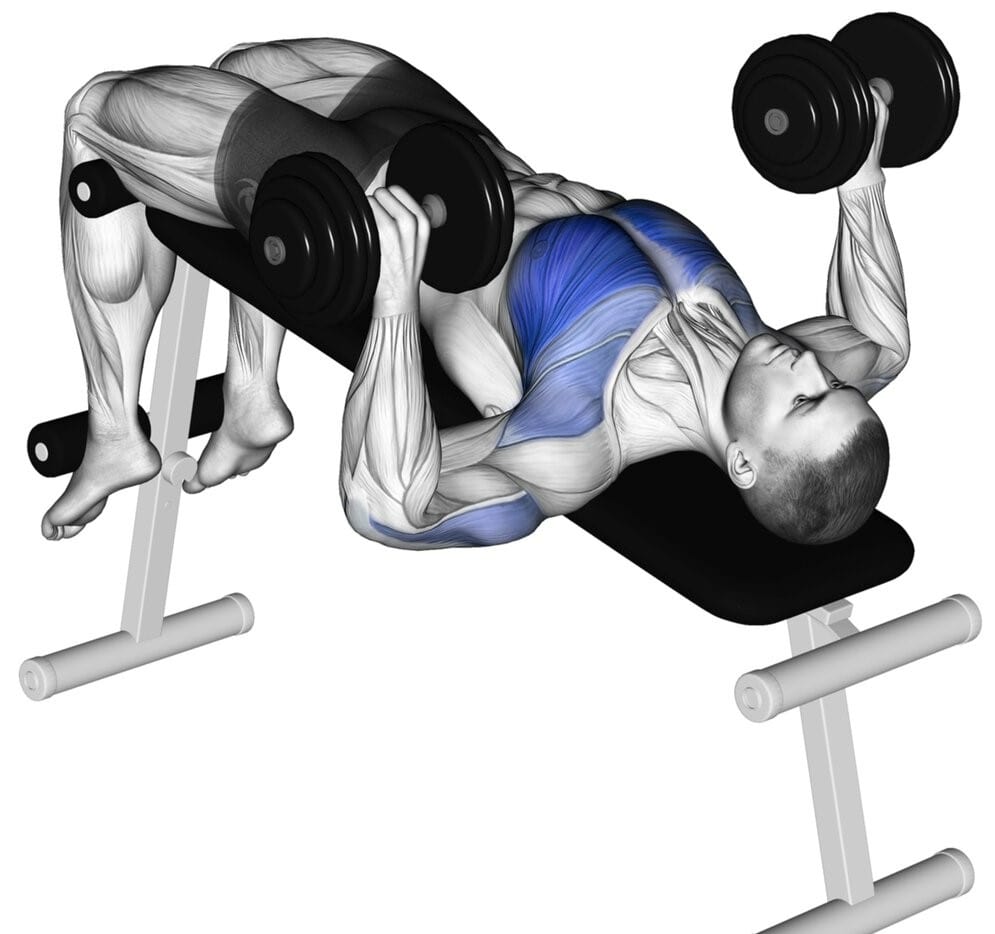
Lie on a decline bench with your head lower than your feet. Hold a dumbbell in each hand and lift them up to your shoulders. Push the dumbbells up towards the ceiling and then lower them down to your chest, keeping your elbows at a 45-degree angle. This exercise targets the lower chest muscles more than the incline press.
Dumbbell Pullovers
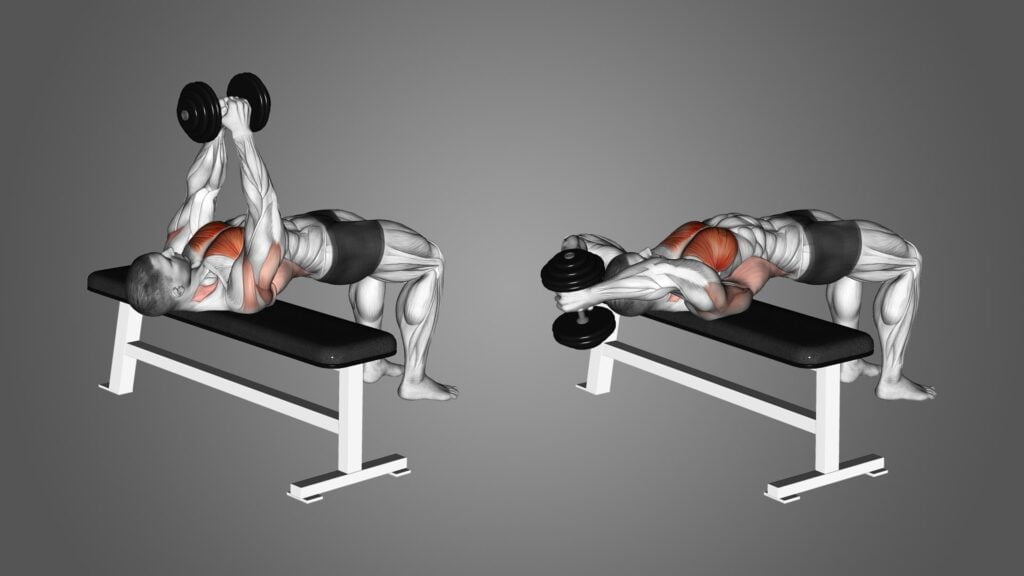
Lie on a flat bench with your feet firmly on the ground. Hold a dumbbell in both hands and extend your arms over your chest. Lower the weight behind your head and then bring it back up over your chest. This exercise targets the chest and back muscles.
Push-up Variations with Dumbbells
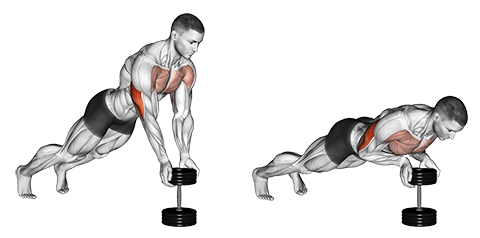
Get into a push-up position with your hands on the dumbbells. Lower your body down towards the floor and then push back up. This exercise targets the chest muscles, including the lower chest.
Dumbbell Chest Fly
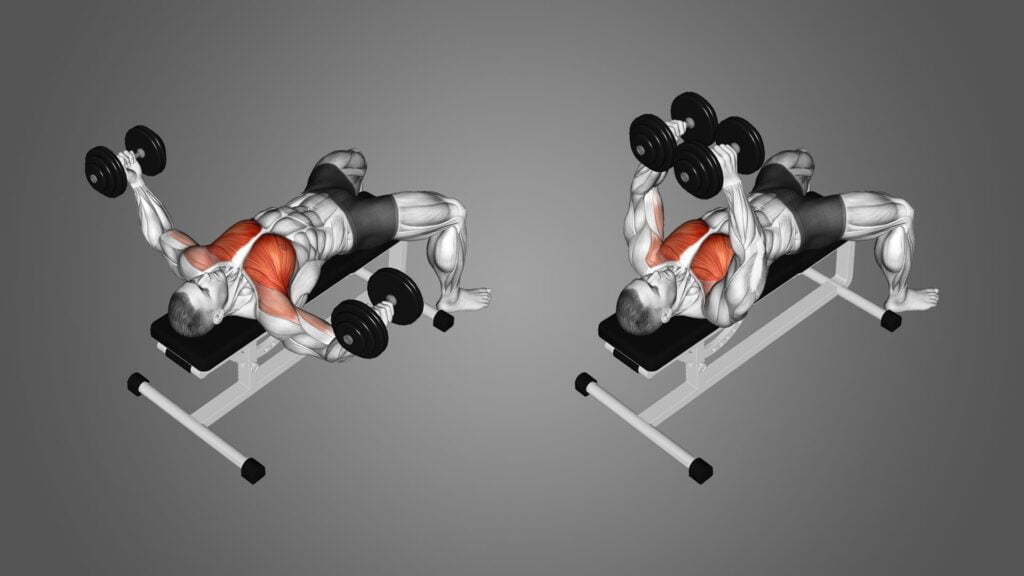
Lie on a flat bench with a dumbbell in each hand. Extend your arms over your chest, keeping a slight bend in your elbows. Lower the weights out to your sides, feeling a stretch in your chest, and then bring them back up over your chest. This exercise isolates the chest muscles and helps to focus on the lower chest.
Incline Dumbbell Fly
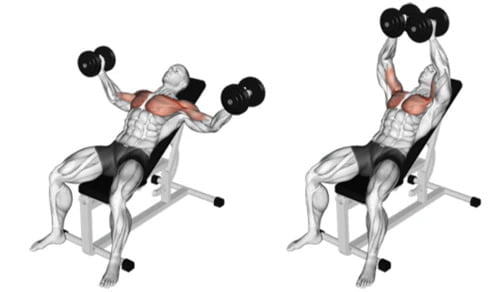
Lie on an incline bench with a dumbbell in each hand. Extend your arms over your chest, keeping a slight bend in your elbows. Lower the weights out to your sides in a wide arc, feeling a stretch in your chest, and then bring them back up over your chest. This exercise targets the upper and lower chest muscles.
Decline Dumbbell Fly

Lie on a decline bench with a dumbbell in each hand. Extend your arms over your chest, keeping a slight bend in your elbows. Lower the weights out to your sides in a wide arc, feeling a stretch in your chest, and then bring them back up over your chest. This exercise targets the lower chest muscles more than the incline fly.
Close Grip Dumbbell Bench Press

Lie on a flat bench with a dumbbell in each hand. Hold the dumbbells with your palms facing each other, and your hands close together. Push the dumbbells up towards the ceiling and then lower them down to your chest, keeping your elbows close to your body. This exercise targets the triceps and the lower chest muscles.
Dumbbell Pullover on Stability Ball
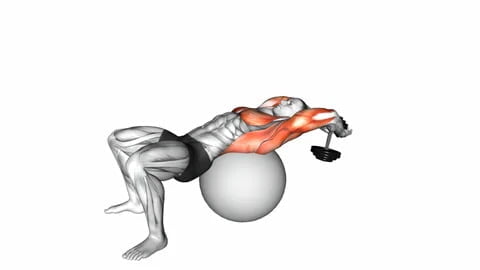
Lie on a stability ball with your feet firmly on the ground. Hold a dumbbell in both hands and extend your arms over your chest. Lower the weight behind your head and then bring it back up over your chest. This exercise targets the chest and back muscles, and the use of the stability ball helps to engage the core muscles as well.
Remember to always warm-up before starting your workout, and cool down and stretch after you finish. Rest for a day or two between chest workouts to allow your muscles to recover and grow. With consistency and dedication, a Dumbbell Lower Chest Workout can help you achieve a stronger, more defined chest.
Modifications for Beginners
For beginners, some of the exercises in a Dumbbell Lower Chest Workout may be challenging due to limited mobility or strength. Here are some modifications that can be made to make the exercises more accessible:
1. Incline Dumbbell Bench Press
- Start with a lower incline angle or perform the exercise on a flat bench instead of an incline bench
- Use lighter weights and focus on proper form before increasing the weight
- If necessary, perform the exercise with one dumbbell at a time to help with balance and stability
2. Decline Dumbbell Bench Press
- Start with a small decline angle or perform the exercise on a flat bench instead of a decline bench
- Use lighter weights and focus on proper form before increasing the weight
- If necessary, perform the exercise with one dumbbell at a time to help with balance and stability
3. Dumbbell Pullovers
- Start with a lighter weight and focus on proper form before increasing the weight
- If necessary, perform the exercise with one dumbbell at a time to help with balance and stability
- Place a pillow or cushion under your upper back to provide support and reduce strain on your shoulders
4. Push-up Variations with Dumbbell
- Start with modified push-ups on your knees or against a wall
- Use lighter weights and focus on proper form before increasing the weight
- If necessary, perform the exercise with one dumbbell at a time to help with balance and stability
5. Dumbbell Chest Fly
- Start with a lighter weight and focus on proper form before increasing the weight
- Use a stability ball or a bench with a lower incline to provide support and reduce strain on your shoulders
6. Incline Dumbbell Fly
- Start with a lower incline angle or perform the exercise on a flat bench instead of an incline bench
- Use lighter weights and focus on proper form before increasing the weight
- If necessary, perform the exercise with one dumbbell at a time to help with balance and stability
7. Decline Dumbbell Fly
- Start with a small decline angle or perform the exercise on a flat bench instead of a decline bench
- Use lighter weights and focus on proper form before increasing the weight
- If necessary, perform the exercise with one dumbbell at a time to help with balance and stability
8. Close Grip Dumbbell Bench Press
- Start with a lighter weight and focus on proper form before increasing the weight
- Use a spotter to assist with the weight if necessary
- If necessary, perform the exercise with one dumbbell at a time to help with balance and stability
9. Dumbbell Pullover on Stability Ball
- Start with a lighter weight and focus on proper form before increasing the weight
- Use a stability ball that is the appropriate size for your height and weight
- Place your feet firmly on the ground to maintain balance and stability
Advanced Variations
Advanced variations of the Dumbbell Lower Chest Workout can be incorporated to challenge the chest muscles further and increase the intensity of the workout. Here are some examples:
- Drop Sets: This involves performing an exercise with a heavy weight until failure, then immediately reducing the weight and continuing the exercise until failure again. For example, start with a heavy weight for dumbbell incline bench press for 6-8 reps, then immediately reduce the weight and perform another set for 6-8 reps with a lighter weight.
- Supersets: This involves performing two different exercises back-to-back without rest. For example, superset dumbbell incline bench press with dumbbell fly. Perform 8-10 reps of incline bench press, then immediately perform 8-10 reps of dumbbell fly without rest.
- Pyramid Sets: This involves starting with a lighter weight and gradually increasing the weight with each set, while decreasing the reps. For example, perform 12 reps of dumbbell incline bench press with a light weight, then increase the weight and perform 10 reps, then increase the weight and perform 8 reps, and so on until you reach a heavy weight.
- Eccentric Training: This involves focusing on the negative or eccentric phase of an exercise. For example, slowly lower the dumbbells during the eccentric phase of dumbbell incline bench press, then explosively lift the dumbbells during the concentric phase.
It is important to note that these advanced variations should only be incorporated once you have mastered the proper form and technique of the basic exercises. Additionally, it is important to consult with a personal trainer or fitness professional before incorporating advanced variations to ensure proper execution and prevent injury.
Nutrition and Recovery
Nutrition is essential to fueling your body for a Dumbbell Lower Chest Workout. Eating the right foods before and after your workout can help improve your performance and support muscle growth and recovery. Before your workout, you want to consume foods that provide energy, such as complex carbohydrates, lean protein, and healthy fats. Some examples of pre-workout snacks could include a banana with almond butter or Greek yogurt with berries.
After your Dumbbell Lower Chest Workout, your body needs proper nutrition to help repair and rebuild your muscles. Consuming protein after your workout is particularly important, as it provides the building blocks your body needs to repair muscle tissue. You should aim to consume protein within 30 minutes to an hour of your workout to maximize recovery. Some examples of post-workout snacks could include a protein shake or a turkey sandwich on whole-grain bread.
Recovery is also an essential part of a Dumbbell Lower Chest Workout. When you lift weights, you create small tears in your muscle fibers, which your body then repairs and rebuilds stronger than before. However, your body needs time to recover and repair these muscle fibers. Adequate rest and recovery can help prevent injury, reduce muscle soreness, and improve your overall performance. Some ways to aid in recovery include stretching, foam rolling, and getting enough sleep.
In summary, proper nutrition and recovery are crucial for a successful Dumbbell Lower Chest Workout. Eating the right foods before and after your workout and allowing adequate time for recovery can help improve your performance, prevent injury, and support muscle growth and repair.
Safety Precautions
When performing a Dumbbell Lower Chest Workout, it is important to take certain safety precautions to avoid any risk of injury. Here are some safety precautions that you should follow:
- Start with a warm-up: Before beginning your workout, it is essential to warm up your chest muscles with some dynamic stretches and exercises. This will increase blood flow to the muscles and reduce the risk of injury.
- Choose the right weight: It is important to choose the right weight for each exercise. If you use too heavy weights, you can strain your muscles or cause an injury. Start with lighter weights and gradually increase the weight as you get stronger.
- Use proper form and technique: Using proper form and technique is essential to prevent injuries. Make sure you maintain the correct posture and keep your back straight while performing exercises. Also, avoid locking your joints while lifting weights.
- Use a spotter: If you are lifting heavy weights, it is always a good idea to have a spotter. A spotter can assist you in lifting weights and ensure your safety during the workout.
- Listen to your body: If you feel pain or discomfort while performing an exercise, stop immediately. Pushing through pain can lead to serious injuries.
By following these safety precautions, you can minimize the risk of injury and enjoy a safe and effective Dumbbell Lower Chest Workout.
Motivation and Goal-Setting
Motivation and goal-setting are essential factors for achieving success in any fitness program, including a Dumbbell Lower Chest Workout. Here are some tips to help you stay motivated and set achievable goals:
- Find your Why: Understanding your reasons for wanting to improve your chest muscles will help you stay motivated. It could be for aesthetic reasons, improved overall health, or increased strength for other activities.
- Set SMART Goals: When setting goals, use the SMART framework: Specific, Measurable, Achievable, Relevant, and Time-bound. For example, setting a goal to increase the number of sets and reps for each exercise over six weeks.
- Track Your Progress: Keeping a record of your progress can help you stay motivated and see the changes happening in your chest muscles. You can use a workout journal or an app to track your progress and monitor your goals.
- Mix it up: Variety is essential to avoid boredom and keep your workouts challenging. You can switch up your exercises or add new variations to keep things fresh and exciting.
- Celebrate Your Success: When you reach a milestone or achieve a goal, take time to celebrate and reward yourself. This will help you stay motivated and focused on your next goal.
In summary, staying motivated and setting achievable goals is critical for a successful Dumbbell Lower Chest Workout. Use the SMART framework, track your progress, mix up your exercises, and celebrate your success along the way.
Cool down and Stretching
After completing a Dumbbell Lower Chest Workout, it is important to perform a cool down and stretching routine to prevent muscle soreness and reduce muscle tension. Cool down refers to the process of gradually decreasing the intensity of the workout, allowing the heart rate and breathing to return to normal.
Stretching is a crucial part of the cool-down process, which involves holding a static stretch for a particular muscle group for a certain amount of time. Stretching helps to improve flexibility, reduce muscle stiffness, and prevent injury.
In a Dumbbell Lower Chest Workout, the cool-down and stretching routine should focus on the chest, shoulder, and triceps muscles. Some examples of chest stretches include chest stretch against a wall, doorway chest stretch, or lying chest stretch. Shoulder stretches can include arm circles or shoulder stretch against a wall. For the triceps, a triceps stretch can be performed by reaching your arm behind your head and gently pulling on the elbow with the opposite hand.
It is important to hold each stretch for at least 15-30 seconds without bouncing or forcing the stretch. The cool-down and stretching routine should be performed immediately after the workout when the muscles are warm, and then repeated again after a few hours or the next day to maximize the benefits.
Common Mistakes to Avoid
When performing a Dumbbell Lower Chest Workout, there are some common mistakes that you should avoid to prevent injuries and ensure effective results. Some of these mistakes include:
Improper Form
One of the most common mistakes is not maintaining proper form during exercises. This can lead to poor results and even injury. Ensure that you use the correct form for each exercise, such as keeping your back straight and shoulders down during a dumbbell chest fly.
Lifting too Heavy
Lifting too heavy weights can cause injury and lead to poor form. Start with lighter weights and gradually increase the weights over time.
Neglecting Warm-Up
Skipping warm-up exercises can lead to injuries and negatively affect your performance. Warm-up exercises help to prepare your muscles and joints for the workout. You can warm up by doing dynamic stretches, such as arm circles and push-up variations.
Not Enough Variety
Focusing on only one or two exercises can limit the results and neglect other muscle groups. Incorporate a variety of exercises to target different areas of the lower chest muscles.
Not Resting Enough
Not allowing enough time for rest and recovery between workouts can lead to muscle fatigue and slow progress. Give your muscles enough time to rest and recover between workouts.
By avoiding these common mistakes, you can optimize your Dumbbell Lower Chest Workout and achieve better results.
Conclusion
In conclusion, the Dumbbell Lower Chest Workout can help to develop and strengthen the lower chest muscles, leading to a well-rounded chest and improved overall fitness.
Recapping the exercises and their benefits, the incline dumbbell bench press targets the upper and lower chest muscles, the decline dumbbell bench press focuses more on the lower chest muscles, the dumbbell pullovers engage the chest and back muscles, push-up variations with dumbbells target the chest muscles, including the lower chest, and the dumbbell chest fly isolates the chest muscles, helping to focus on the lower chest.
It is important to follow a proper form while performing the exercises and gradually increase the weights to avoid injury and achieve maximum benefits.
We also recommend consulting with a personal trainer or fitness professional for personalized advice and to help create a workout plan tailored to your fitness goals and needs. With consistent effort and proper guidance, the Dumbbell Lower Chest Workout can lead to a stronger, more defined lower chest and improved overall fitness.

Good day, and welcome to Fitthour. My name is Shubham Vijay, and I am a certified personal trainer and nutrition coach with 6 years of experience in the fitness industry. At Fitthour, we specialize in types of training, such as strength training, cardio, or HIIT, and our mission is to help clients achieve their fitness goals and improve their overall health.
